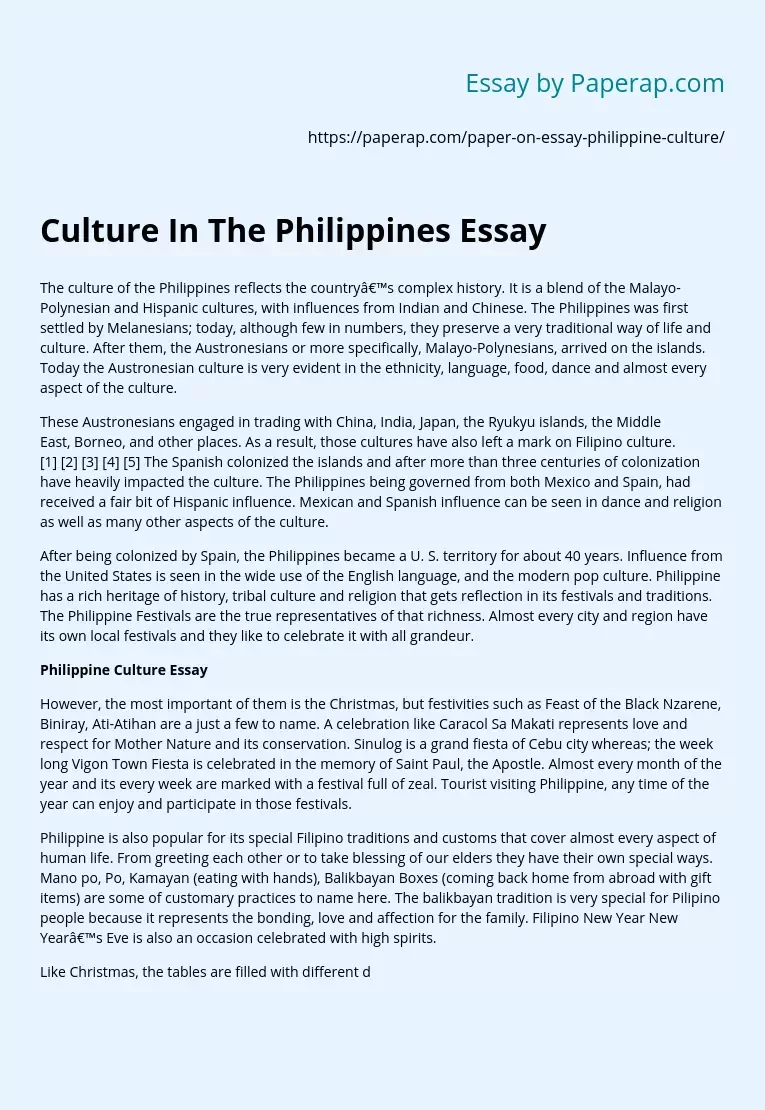The culture of the Philippines reflects the country’s complex history. It is a blend of the Malayo-Polynesian and Hispanic cultures, with influences from Indian and Chinese. The Philippines was first settled by Melanesians; today, although few in numbers, they preserve a very traditional way of life and culture. After them, the Austronesians or more specifically, Malayo-Polynesians, arrived on the islands. Today the Austronesian culture is very evident in the ethnicity, language, food, dance and almost every aspect of the culture.
These Austronesians engaged in trading with China, India, Japan, the Ryukyu islands, the Middle East, Borneo, and other places. As a result, those cultures have also left a mark on Filipino culture. [1] [2] [3] [4] [5] The Spanish colonized the islands and after more than three centuries of colonization have heavily impacted the culture. The Philippines being governed from both Mexico and Spain, had received a fair bit of Hispanic influence.
Mexican and Spanish influence can be seen in dance and religion as well as many other aspects of the culture.
After being colonized by Spain, the Philippines became a U. S. territory for about 40 years. Influence from the United States is seen in the wide use of the English language, and the modern pop culture. Philippine has a rich heritage of history, tribal culture and religion that gets reflection in its festivals and traditions. The Philippine Festivals are the true representatives of that richness.
Almost every city and region have its own local festivals and they like to celebrate it with all grandeur.
Philippine Culture Essay
However, the most important of them is the Christmas, but festivities such as Feast of the Black Nzarene, Biniray, Ati-Atihan are a just a few to name. A celebration like Caracol Sa Makati represents love and respect for Mother Nature and its conservation. Sinulog is a grand fiesta of Cebu city whereas; the week long Vigon Town Fiesta is celebrated in the memory of Saint Paul, the Apostle. Almost every month of the year and its every week are marked with a festival full of zeal. Tourist visiting Philippine, any time of the year can enjoy and participate in those festivals.
Philippine is also popular for its special Filipino traditions and customs that cover almost every aspect of human life. From greeting each other or to take blessing of our elders they have their own special ways. Mano po, Po, Kamayan (eating with hands), Balikbayan Boxes (coming back home from abroad with gift items) are some of customary practices to name here. The balikbayan tradition is very special for Pilipino people because it represents the bonding, love and affection for the family. Filipino New Year New Year’s Eve is also an occasion celebrated with high spirits.
Like Christmas, the tables are filled with different dishes. Families make it a point to place twelve kinds of round fruits on their table. This practice supposedly ushers in good fortune and happiness for the whole year. Many believe that misfortune, misery and bad luck knocks at the door of the families who fail to follow this tradition. All over the world, the arrival of the New Year is welcomed by loud horns, colourful fireworks displays and noisy firecrackers. Nowadays, the creation of silent, colourful, and big pyrotechnics have pushed loud firecrackers to the backseat.
Yet, some Filipinos still appreciate the noisy explosives and light them up on twelve midnight every January 1st. Another New Year tradition is placing coins inside the pockets of the shirt or the pants. Filipinos do this to attract money for the whole year. Round objects symbolize prosperity and fortune. Polka dots are a favourite pattern during welcoming the new year. Almost all family members have coins in their pockets or polka dots to have a great year. Filipino Christmas The Philippines is a country known for its rich culture, history and heritage.
Through the years, Filipinos have created and passed down important values and traditions to the next generation. These traditions are celebrations, part of the celebration or simple family practices. Filipinos and their families respect traditions, a reason why traditions are still being practiced today. Filipinos are fond of the holidays especially christmas and new year’s day. During these days, spirits are up and excitement can be felt. A few days before christmas, catholics observe the simbang gabi or the nine day novena mass.
Families can be seen, with children in tow, even at 4 in the morning, hustling to churches. After the mass, the staple foods bought outside the church are puto and pandesal. These are paired with a cup of coffee or hot chocolate to start the mornings. Families get together during christmas eve. They prepare a special dinner and sit around the table, celebrating the special occasion. An indispensable item on the table during christmas is the queso de bola. Translated, it means a ball of cheese, covered with a red wax and serve it with bread.
Culture In The Philippines Essay. (2019, Dec 05). Retrieved from https://paperap.com/paper-on-essay-philippine-culture/

